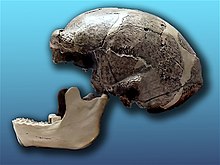Peking Man
| Peking man Temporal range: |
|
|---|---|
 |
|
| First cranium of Homo erectus pekinensis (Sinanthropus pekinensis) discovered in 1929 in Zhoukoudian, today missing (replica) | |
| Scientific classification | |
| Kingdom: | Animalia |
| Phylum: | Chordata |
| Class: | Mammalia |
| Order: | Primates |
| Suborder: | Haplorhini |
| Family: | Hominidae |
| Genus: | Homo |
| Species: | †H. erectus |
| Subspecies: | †H. e. pekinensis |
| Trinomial name | |
|
Homo erectus pekinensis (Black, 1927) |
|
| Synonyms | |
|
Sinanthropus pekinensis |
|
Sinanthropus pekinensis
Peking Man (Chinese: 北京猿人; pinyin: Běijīng Yuánrén), Homo erectus pekinensis (formerly known by the junior synonym Sinanthropus pekinensis), is an example of Homo erectus. Discovered in 1923–27 during excavations at Zhoukoudian (Chou K'ou-tien) near Beijing (written "Peking" before the adoption of the Pinyin romanization system), China, in 2009 this group of fossil specimens dated from roughly 750,000 years ago, and a new 26Al/10Be dating suggests they are in the range of 680,000–780,000 years old.
Between 1929 and 1937, 15 partial crania, 11 mandibles, many teeth, some skeletal bones and large numbers of stone tools were discovered in the Lower Cave at Locality 1 of the Peking Man site at Zhoukoudian, near Beijing, in China. Their age is estimated to be between 500,000 and 300,000 years old. (A number of fossils of modern humans were also discovered in the Upper Cave at the same site in 1933.) The most complete fossils, all of which were calvariae, are:
Most of the study on these fossils was done by Davidson Black until his death in 1934. Pierre Teilhard de Chardin took over until Franz Weidenreich replaced him and studied the fossils until he left China in 1941. The original fossils disappeared in 1941, but excellent casts and descriptions remain.
Swedish geologist Johan Gunnar Andersson and American palaeontologist Walter W. Granger came to Zhoukoudian, China in search of prehistoric fossils in 1921. They were directed to the site at Dragon Bone Hill by local quarrymen, where Andersson recognised deposits of quartz that were not native to the area. Immediately realising the importance of this find he turned to his colleague and announced, "Here is primitive man; now all we have to do is find him!"
...
Wikipedia
